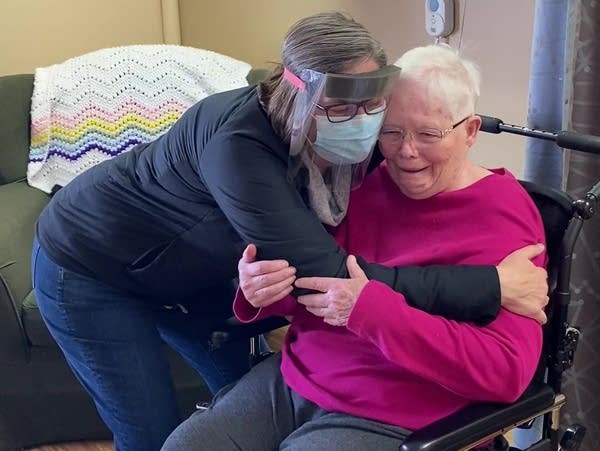As nursing homes open up, families, operators remember COVID's torment, focus on what's next

Go Deeper.
Create an account or log in to save stories.
Like this?
Thanks for liking this story! We have added it to a list of your favorite stories.
In late March, Deb Achenbach got to do something she’s done a thousand times before — She hugged her mother for the first time in more than a year.
In fact that whole time, Achenbach couldn’t even touch her mother, and rarely saw her in person.
More than a year into the COVID-19 pandemic, families, administrators, staff and residents are cautiously moving into a post-vaccine life. They do so while holding onto the memories of one of the most devastating years in the history of long-term care. The most recent Minnesota health data shows residents of long-term care facilities, including nursing homes, were 62 percent of all COVID-19-related deaths.
For all, it has been a year of pain and change.
Turn Up Your Support
MPR News helps you turn down the noise and build shared understanding. Turn up your support for this public resource and keep trusted journalism accessible to all.
Achenbach’s 86-year-old mother has dementia and lives in a Dodge Center, Minn., nursing home. She’s been there two years. Just before nursing homes were closed to visitors, they celebrated her mother’s birthday together as a family.
“At least if I wasn't going to be able to see her, at least I saw her like a high point,” Achenbach said.
During the lockdown, Achenbach worried about her mother’s isolation. Before the pandemic, Achenbach’s father had visited her mother every day, coming for dinner to help feed her.
Through FaceTime calls and outdoor visits during the pandemic, she and her father have seen a decline in her mother, who often seemed sleepier than before the pandemic.
“I think we thought that once we were in person that it would change,” she said. “And I don't know if it's going to. I think she's just naturally declining due to her dementia.”
More recently, Achenbach has noticed some improvement. She isn’t sure if her mother is more present and clearer because things have opened up, but thinks physical presence and touch have helped.
The pandemic changed Achenbach’s relationship with her father.
“I think I've gotten closer to my dad because of my having to check in with him and we've been keeping track of mom,” she said.
COVID-19 was an uncontrollable fire for Barb Rode, the CEO and President of St. Therese, a long-term care facility in New Hope, Minn. Between April and June, nearly 70 residents at St. Therese died of COVID-19.
“It was just heartbreaking,” Rode said.
St. Therese’s design didn’t help. In many cases, a room had two people who shared a bathroom with another room, putting four people in proximity to each other.
At that time, testing was only for people showing symptoms. Rode said early in the pandemic they thought people without symptoms “were fine,” which was the guidance then.
But when the home tested everyone, they found that more than one-third of positive cases were asymptomatic, so the spread was happening unseen.
St. Therese made a change, eliminating 90 beds and creating more private rooms, “so we could try to control it better,” Rode said. The New Hope facility went from 258 to 168 beds.

For Rode and others at St. Therese, it was a devastating year — in which everyone suffered, even if they survived COVID-19. Families were separated from loved ones; the staff struggled with illness and the difficult work.
“I just was so upset, and so sad. And so I felt like there was nothing we could do about it,” she said. “But once you start working with your staff and seeing the thought process and how to deal with this whole thing, it just makes you feel good.”
In St. Paul’s Lyngblomsten Care Center, more than 20 people died from COVID-19 over the summer.
Vaccinations rolled out at Lyngblomsten in late December. Since then about 95 percent of residents and 75 percent of staff have been vaccinated. Greg Wainman, the director of nursing, said the high level of stress, the constant changes in guidance and the demands of daily work in the pandemic, changed how decisions were made.
“Because there was so much work, and it was changing so quickly. It forced us to rely more on each other and kind of work more collaboratively,” he said.
Wainman said decisions that were often happening in silos are happening much more collaboratively now, a holdover from more dire times. “We kind of had to kind of band together,” he said. “And I think that that changed it in a good way.”
Wainman said that vaccinations help normal life to return.
“I don't think we'll ever be exactly like it was before, but maybe a little bit more like that,” he said.




